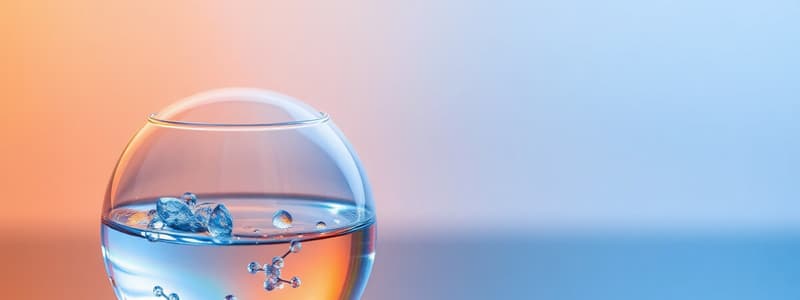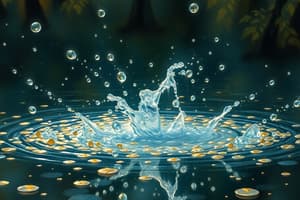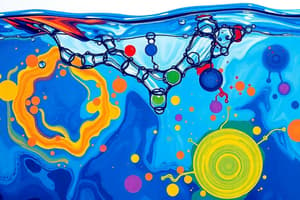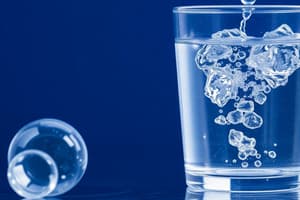Podcast
Questions and Answers
What percentage of the human body is approximately made up of water?
What percentage of the human body is approximately made up of water?
- 50–60 percent
- 40–50 percent
- 70–80 percent
- 60–70 percent (correct)
Which property of water is primarily responsible for its ability to form hydrogen bonds?
Which property of water is primarily responsible for its ability to form hydrogen bonds?
- Dissociation into ions
- Hydrophobic interactions
- High heat capacity
- Polarity of the molecule (correct)
What term is used to describe substances that do not interact well with water?
What term is used to describe substances that do not interact well with water?
- Polar
- Ionic
- Hydrophobic (correct)
- Hydrophilic
What is the significance of water's high heat capacity?
What is the significance of water's high heat capacity?
Why is water termed a unique substance essential for life?
Why is water termed a unique substance essential for life?
How does water's polarity contribute to its solvent capabilities?
How does water's polarity contribute to its solvent capabilities?
What process in water leads to the generation of pH?
What process in water leads to the generation of pH?
What is the effects of water's adhesive properties in biological systems?
What is the effects of water's adhesive properties in biological systems?
What characterizes strong acids compared to weak acids?
What characterizes strong acids compared to weak acids?
Which statement about the pH scale is accurate?
Which statement about the pH scale is accurate?
How do buffers maintain pH in the body?
How do buffers maintain pH in the body?
Why is the replacement of stomach cells critical?
Why is the replacement of stomach cells critical?
What is the role of bicarbonate ions in blood pH regulation?
What is the role of bicarbonate ions in blood pH regulation?
Which of the following substances is considered a weak base?
Which of the following substances is considered a weak base?
What occurs when strong bases are introduced to a solution?
What occurs when strong bases are introduced to a solution?
Why is maintaining a near-neutral pH important for organisms?
Why is maintaining a near-neutral pH important for organisms?
How do antacids function similarly to blood buffers?
How do antacids function similarly to blood buffers?
In terms of pH, what environment is considered inhospitable to life?
In terms of pH, what environment is considered inhospitable to life?
What characteristic of water allows it to have a lower density in its solid form compared to its liquid form?
What characteristic of water allows it to have a lower density in its solid form compared to its liquid form?
Which process involves the escape of water molecules from liquid to gas at temperatures below boiling point?
Which process involves the escape of water molecules from liquid to gas at temperatures below boiling point?
What is a consequence of ice floating on water for aquatic ecosystems?
What is a consequence of ice floating on water for aquatic ecosystems?
Why does water require a considerable amount of heat to boil?
Why does water require a considerable amount of heat to boil?
What forms around ionic compounds when they dissolve in water?
What forms around ionic compounds when they dissolve in water?
What is the critical factor that causes the breaking of hydrogen bonds in water during boiling?
What is the critical factor that causes the breaking of hydrogen bonds in water during boiling?
How does the hydrogen bonding in water contribute to its role as a heat sink?
How does the hydrogen bonding in water contribute to its role as a heat sink?
What phenomenon occurs when water molecules slide past each other in liquid form?
What phenomenon occurs when water molecules slide past each other in liquid form?
What happens to cellular membranes when ice forms inside them?
What happens to cellular membranes when ice forms inside them?
What is the primary reason that ice floats on liquid water?
What is the primary reason that ice floats on liquid water?
Why is water considered a good solvent for ionic compounds?
Why is water considered a good solvent for ionic compounds?
What energy transformation occurs when water evaporates?
What energy transformation occurs when water evaporates?
Which of the following statements about water’s states is true?
Which of the following statements about water’s states is true?
What is the heat of vaporization for water?
What is the heat of vaporization for water?
What phenomenon allows small insects, like water striders, to stay afloat on the surface of the water?
What phenomenon allows small insects, like water striders, to stay afloat on the surface of the water?
Which of the following best explains why plants can transport water from roots to leaves?
Which of the following best explains why plants can transport water from roots to leaves?
What happens to the pH of a solution when an acid is dissolved in water?
What happens to the pH of a solution when an acid is dissolved in water?
In the context of pH, what does a lower pH number indicate?
In the context of pH, what does a lower pH number indicate?
What is the primary composition of pure water when it ionizes?
What is the primary composition of pure water when it ionizes?
What is the reason for placing a small scrap of paper on a water droplet allowing it to float?
What is the reason for placing a small scrap of paper on a water droplet allowing it to float?
Which of the following best describes capillary action?
Which of the following best describes capillary action?
What is the significance of the pH of 7.0?
What is the significance of the pH of 7.0?
How many moles of H+ ions are produced in pure water per liter at neutral pH?
How many moles of H+ ions are produced in pure water per liter at neutral pH?
Which force is primarily responsible for keeping water droplets spherical on a surface?
Which force is primarily responsible for keeping water droplets spherical on a surface?
What type of bonding typically occurs between water molecules due to cohesion?
What type of bonding typically occurs between water molecules due to cohesion?
Which statement about bases is accurate?
Which statement about bases is accurate?
Why is adhesion stronger than cohesion in a thin glass tube when water is present?
Why is adhesion stronger than cohesion in a thin glass tube when water is present?
What does the negative logarithm measure in relation to pH?
What does the negative logarithm measure in relation to pH?
Flashcards
High Heat Capacity
High Heat Capacity
The ability of a substance to absorb and retain heat, preventing sudden temperature changes.
Heat of Vaporization
Heat of Vaporization
The amount of heat energy needed for a liquid to transform into a gas.
Solvent Properties
Solvent Properties
Water can dissolve many substances due to its polarity, creating a solution.
Cohesive Properties
Cohesive Properties
Attraction between water molecules due to hydrogen bonding.
Signup and view all the flashcards
Adhesive Properties
Adhesive Properties
Attraction between water molecules and other molecules or surfaces.
Signup and view all the flashcards
Dissociation into Ions
Dissociation into Ions
Water can dissociate into ions, creating a pH scale.
Signup and view all the flashcards
Polar molecules
Polar molecules
Molecules with uneven distribution of charges, like water, with a slightly positive and negative end.
Signup and view all the flashcards
Hydrogen Bonding
Hydrogen Bonding
Weak attraction between a slightly positive hydrogen atom and a slightly negative atom of another molecule, like oxygen.
Signup and view all the flashcards
Water's Solvent Properties
Water's Solvent Properties
Water is a polar molecule, meaning it has slightly positive and negative charges. This allows it to dissolve many substances, making it a solvent.
Signup and view all the flashcards
Cohesive Properties Of Water
Cohesive Properties Of Water
The attraction between water molecules due to hydrogen bonding.
Signup and view all the flashcards
Adhesive Properties Of Water
Adhesive Properties Of Water
The attraction between water molecules and other molecules or surfaces. This is caused by hydrogen bonding.
Signup and view all the flashcards
Dissociation Of Water
Dissociation Of Water
The process where water molecules break apart into positively charged hydrogen ions (H+) and negatively charged hydroxide ions (OH-)
Signup and view all the flashcards
Evaporation of Water
Evaporation of Water
The process where the hydrogen bonds between water molecules break, causing water to transition from liquid to gas.
Signup and view all the flashcards
Freezing Of Water
Freezing Of Water
The process where water molecules slow down and form a crystalline structure maintained by hydrogen bonds.
Signup and view all the flashcards
Ice Is Less Dense Than Liquid Water
Ice Is Less Dense Than Liquid Water
The unique property of water where the solid form (ice) is less dense than the liquid form.
Signup and view all the flashcards
Sphere Of Hydration
Sphere Of Hydration
A sphere of water molecules surrounding an ion or polar molecule in solution, helping to keep it dissolved.
Signup and view all the flashcards
Dissociation Of Ionic Compounds
Dissociation Of Ionic Compounds
The breaking of ionic bonds when an ionic compound dissolves in water, resulting in the formation of ions.
Signup and view all the flashcards
pH Scale
pH Scale
The measure of the acidity or alkalinity of a solution, based on the concentration of hydrogen ions (H+).
Signup and view all the flashcards
Thermal Inertia
Thermal Inertia
The ability of a substance to resist changes in temperature.
Signup and view all the flashcards
What is an acid?
What is an acid?
A substance that readily donates hydrogen ions (H+). Strong acids completely dissociate in water, while weak acids only partially dissociate.
Signup and view all the flashcards
What is a base?
What is a base?
A substance that readily accepts hydrogen ions (H+) or donates hydroxide ions (OH-). Strong bases completely dissociate in water, while weak bases only partially dissociate.
Signup and view all the flashcards
What is the pH scale?
What is the pH scale?
A measure of the concentration of hydrogen ions (H+) in a solution. It ranges from 0 to 14, with lower numbers indicating higher acidity and higher numbers indicating higher alkalinity.
Signup and view all the flashcards
What is a buffer?
What is a buffer?
A substance that resists changes in pH by absorbing excess H+ or OH-, thus maintaining a stablepH.
Signup and view all the flashcards
How does the blood buffer system work?
How does the blood buffer system work?
A chemical system in the blood that helps maintain a stable pH by reacting with excess H+ or OH-. It involves carbonic acid (H2CO3), bicarbonate ions (HCO3-), and carbon dioxide (CO2).
Signup and view all the flashcards
What is antacid action?
What is antacid action?
The process of neutralizing excess acid in the stomach. It involves raising the pH of the stomach contents.
Signup and view all the flashcards
What is the stomach pH?
What is the stomach pH?
The natural pH level in the stomach, which is highly acidic, ranging from 1 to 2.
Signup and view all the flashcards
What is the intracellular pH?
What is the intracellular pH?
The natural pH level inside cells, which is slightly acidic and close to neutral, around 6.8.
Signup and view all the flashcards
What is the blood pH?
What is the blood pH?
The natural pH level of blood, which is slightly alkaline and very tightly regulated to maintain homeostasis, around 7.4.
Signup and view all the flashcards
What is homeostasis?
What is homeostasis?
The process of maintaining a constant internal environment, including stable pH levels, despite external changes.
Signup and view all the flashcards
Cohesion
Cohesion
The attraction between water molecules due to hydrogen bonding, giving water a strong surface tension.
Signup and view all the flashcards
Adhesion
Adhesion
The attraction between water molecules and other molecules, often stronger than cohesion when water is exposed to charged surfaces.
Signup and view all the flashcards
Capillary Action
Capillary Action
The ability of water to move upward in narrow spaces against the force of gravity, caused by adhesion and cohesion.
Signup and view all the flashcards
pH
pH
A measure of the hydrogen ion concentration in a solution, indicating its acidity or alkalinity.
Signup and view all the flashcards
Acid
Acid
A substance that releases hydrogen ions (H+) when dissolved in water, increasing its acidity & reducing its pH.
Signup and view all the flashcards
Base
Base
A substance that accepts hydrogen ions (H+) or releases hydroxide ions (OH-) in water, decreasing its acidity & increasing its pH.
Signup and view all the flashcards
Buffer
Buffer
A substance that resists changes in pH, maintaining a stable pH level in a solution by neutralizing both acids and bases.
Signup and view all the flashcards
Dissociation
Dissociation
The process by which water molecules break down into a hydrogen ion (H+) and a hydroxide ion (OH-).
Signup and view all the flashcards
Mole (mol)
Mole (mol)
A unit used to express the amount of a substance, equivalent to 6.02 x 10^23 particles of that substance.
Signup and view all the flashcards
Hydronium Ion (H3O+)
Hydronium Ion (H3O+)
A chemical species formed by the combination of a hydrogen ion (H+) with a water molecule (H2O).
Signup and view all the flashcards
pH Paper
pH Paper
A type of chemical test paper used to measure the pH of a solution.
Signup and view all the flashcards
Hydration
Hydration
The process of forming spheres of hydration around ions by water molecules when dissolved in water. (Ex: Salt dissolving in water)
Signup and view all the flashcardsStudy Notes
Importance of Water for Life
- Water is essential for life as we know it, comprising 60-70% of the human body.
- Its unique properties, arising from polarity and hydrogen bonding, are crucial to biological processes.
- Life originated in a watery environment, and most cellular functions occur in the watery cytoplasm.
Water's Polarity
- Water molecules (H₂O) have polar covalent bonds, creating slightly positive hydrogen and slightly negative oxygen regions.
- This polarity allows water to form hydrogen bonds with other water molecules and polar substances.
- Hydrophilic substances readily dissolve in water, while hydrophobic substances, like oils, do not.
Water's States: Gas, Liquid, and Solid
- Hydrogen bonds constantly form and break in liquid water, influenced by temperature.
- Increased heat breaks hydrogen bonds, allowing water to become a gas (evaporation).
- Decreased temperature creates a crystalline solid structure (ice), with hydrogen bonds maintaining spacing, making it less dense than liquid water.
- This phenomenon allows ice to float, providing insulation for aquatic life. Freezing damages cells due to ice crystal expansion.
Water's Heat of Vaporization
- Water has a high heat capacity and heat of vaporization (586 cal/g).
- This is due to the strong hydrogen bonding that requires substantial energy to separate water molecules.
- Evaporation cools the environment, vital for temperature regulation in living organisms like humans (sweating).
Water's Solvent Properties
- Water's polarity allows it to dissolve many ionic and polar substances.
- Water molecules form hydration spheres around dissolved ions, keeping them dispersed.
- Ionic compounds (e.g., NaCl) dissociate into ions when added to water, each ion surrounded by hydration shells.
Water's Cohesive and Adhesive Properties
- Cohesion is the attraction between water molecules due to hydrogen bonding, creating surface tension.
- Surface tension allows objects denser than water to float (e.g., needles on water).
- Adhesion is the attraction between water molecules and other charged surfaces. Capillary action is an example of adhesion in narrow tubes.
- Cohesion and adhesion are vital for water transport in plants, and for some insects (e.g., water striders) to stay afloat.
pH, Buffers, Acids, and Bases
- pH measures the concentration of hydrogen ions (H⁺) in a solution.
- Pure water has a neutral pH of 7.0, while acidic solutions have lower pH values, and alkaline solutions have higher pH values.
- Acids increase H⁺ concentration, while bases decrease it.
- Strong acids/bases completely dissociate, while weak ones only partially dissociate.
- Buffers maintain a relatively constant pH by absorbing excess H⁺ or OH⁻ ions. Human blood and cells utilize these buffering systems (carbonic acid/bicarbonate).
- Stomach acid use buffers (e.g., antacids), due to the need to constantly replace stomach cells that are consumed by stomach acid.
Studying That Suits You
Use AI to generate personalized quizzes and flashcards to suit your learning preferences.




